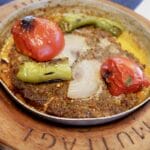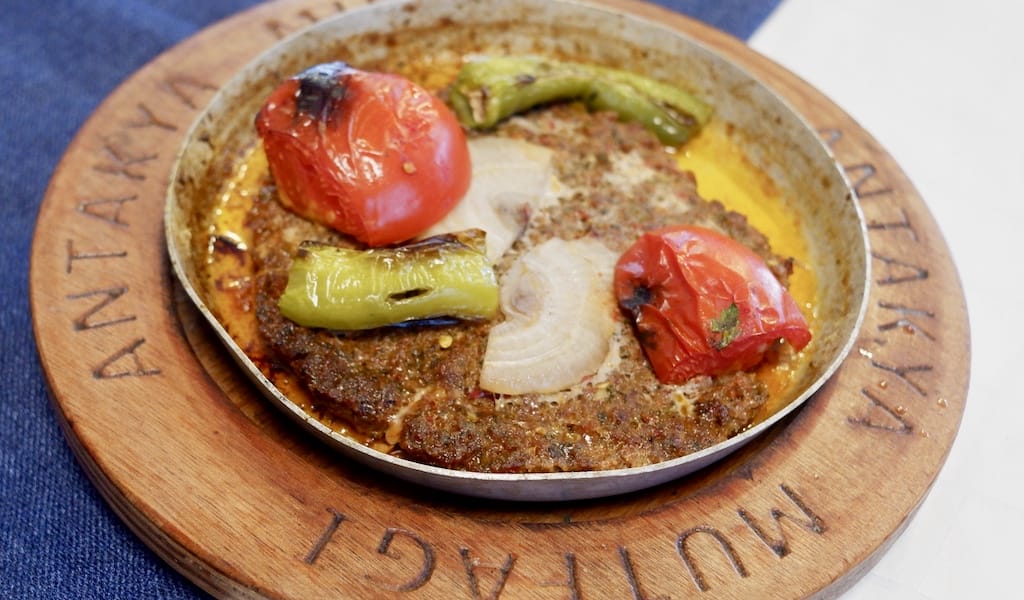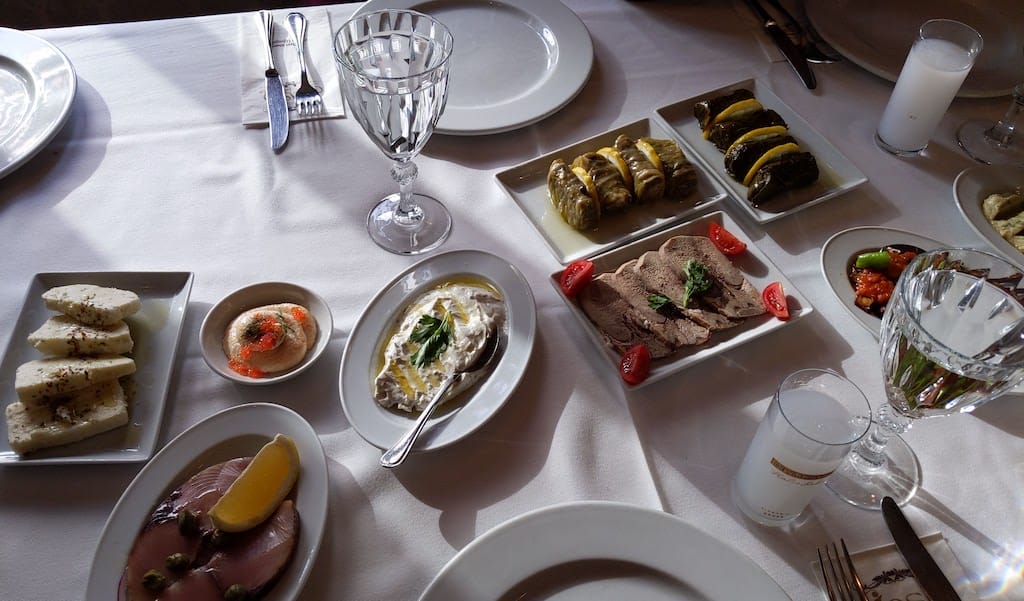Entering Mandy Meydan, a Yemeni restaurant in Başakşehir, a middle-class neighborhood of gated communities in Istanbul, we encountered a dizzying cluster of cubicles, each holding diners seated on a carpeted floor and eating family style.
Amid the din of laughter and clanging metal platters, we quietly called out for our Yemeni friend Abdo. He opened the door to our jalsa, or sitting room, and welcomed us in to rest on the floor. As we shifted around hulking pillows and colorful cushions to prepare for our feast, Abdo, always-smiling, asked us what we would like. Mandi from Hadramout, zurbian from Aden, or fahsa from Sana’a? The list went on. “Open the menu and look. It’s a culinary map of Yemen,” he said with a toothy grin.
It’s a map Istanbulites should be getting familiar with. Non-Turkish restaurants are conquering the food sector in many of Istanbul’s immigrant-heavy neighborhoods, such as in Fatih, Esenyurt and Başakşehir. But while Syrian falafel and Uzbek plov may have now become staples in Istanbul, Yemeni food is the upstart. Unlike the typical Middle Eastern foods that many are well-acquainted with, the lesser-known Yemeni kitchen offers a diverse range of comfort foods and today Istanbul has a growing number of inviting spots in which to try them.
Yemenis began to arrive in Istanbul in larger number in 2015, driven out by the civil war in their country. The Istanbul Yemeni community is estimated to be upwards of 40,000 today, and businessmen have increasingly been opening restaurants for the growing diaspora as well as for Arab tourists, especially from the Gulf, who are fans of Yemen’s cuisine.
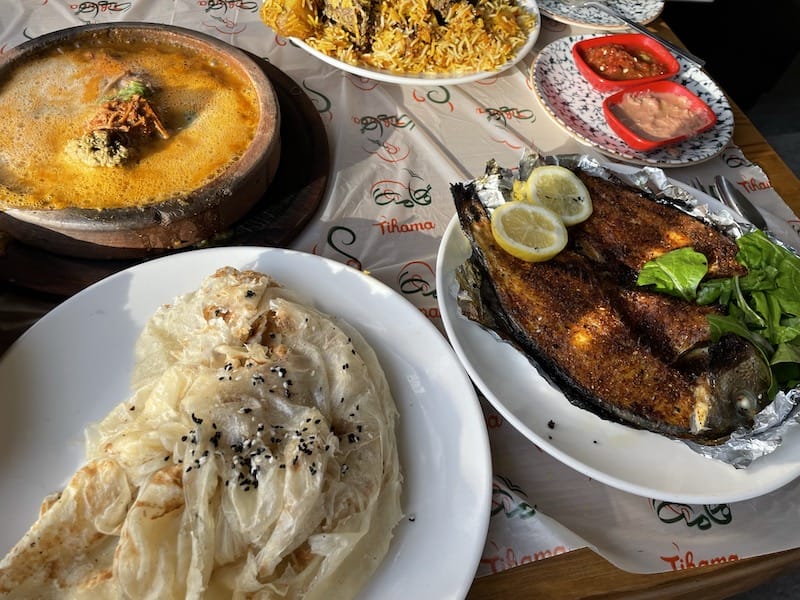
In a region of the world where everyone claims to be the crossroads, since antiquity, perched at the tip of the Arabian Peninsula, Yemeni appetites have been particularly fortunate to have been situated along the incense and spice routes. The Romans referred to the area as “Happy Arabia” and one reason for this joy may well have been the country’s gastronomy, with traces from India, east Africa and the Mediterranean. Turmeric, saffron and chilis mark this rich cuisine.
Take the story of saltah, a tangy stew with fenugreek froth, which is placed in a scalding-hot blackened bowl on the floor before us, along with a chili-tomato salsa called sahawek and khubz mulawah, a chewy, hubcap-sized flatbread that serves as our spoon. As is often the case, the country’s national dish started as a meal for the poor. Saltah’s humble origins span back to when the Ottoman Empire controlled Sana’a, situated in the Yemeni highlands. The dish, now a heavyweight at any Yemeni restaurant, was originally made with stewed scraps and leftovers and served to paupers and prisoners. The communal nature of the dish continues to be enjoyed today.
Just as Eve sprung from Adam’s rib, fahsah split from saltah, the former with the addition of a generous heap of shredded beef or lamb. The fahsah at Mandy Meydan was served with soft and stringy beef. Abdo noted, “Beef is always better for cold weather,” given its richer, fattier taste compared to lamb. The hearty dish certainly comforted our stomachs and warmed our fingers and toes in preparation for a cold Istanbul night as we went in search of our next tasty Yemeni bite.
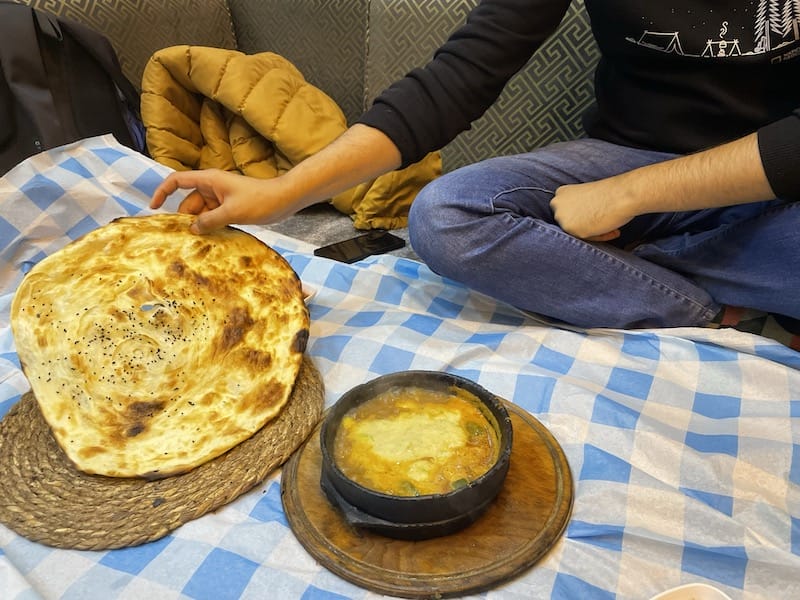
We turned the corner from Mandy Meydan and walked further along the sprawling complex that could serve as the food court for the Arab League. Bright shops sold shawarmas from Aleppo, stuffed vegetables from Baghdad, kibbe from Mosul, and sweet cheese and pastry knafe from Jerusalem. Ahmed Al Amri, with dark curly hair, a thin mustache and a black turtle neck, welcomed us into his restaurant Happy Yemen Mandi.
Al Amri treated us as his guests and even ate with us. The restaurant features photos of Yemen’s UNESCO World Heritage site Socotra Island with its endemic dragon’s blood tree, gilded, bejeweled daggers, and a television screen that showed highlights of Morocco’s historic win over Portugal at the World Cup the night prior.
We feasted on heaping portions of slow-cooked lamb and chicken atop pillows of golden mandi, or spiced, basmati rice, served on silver trays. Mandi is Yemen’s, as well as Happy Yemen Mandi’s, best-known dish. Al Amri spooned extra raisins onto our plates and explained how the meat is usually roasted in a pit underground in the desert. The dish’s name comes from the dewy texture the lamb gets through the process. Unfortunately, this timeless tradition does not adhere to the regulations in the megalopolis’s mini-mall, so Al Amri had a custom above-ground tannour, an urn-shaped oven, built in the restaurant’s kitchen.
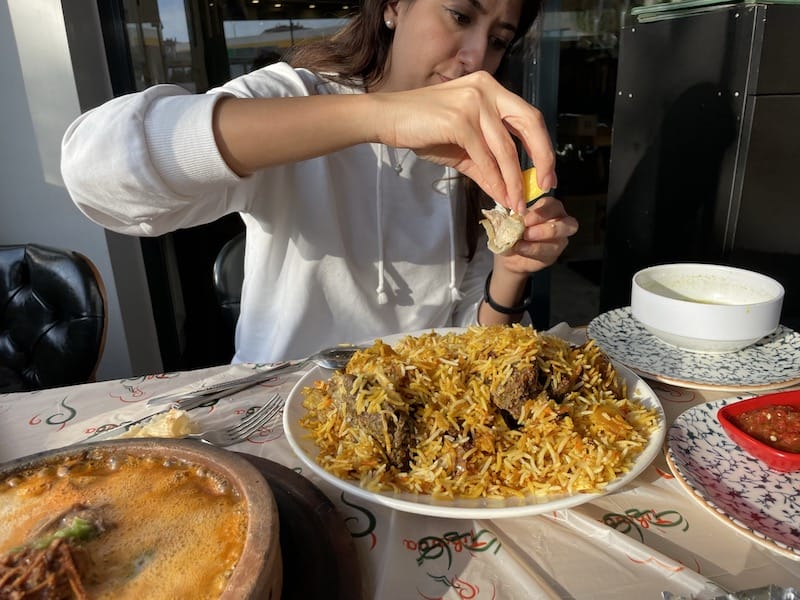
Al Amri explained how, in his hometown of Aden, there were restaurants that specialized only in mandi, which would typically run out by 2 p.m. each day due to high demand. “You need a full stomach before chewing qat leaves,” Al Amri said smiling, referencing the psychoactive stimulant that the nation chomps on in communal fashion each afternoon. However, in Istanbul, Al Amri has a diverse, largely qat-free clientele that sprinkle in day and night, so he offers a wide array of Yemeni and Arab dishes to draw them in. “We are even going to add a shawarma platter on the menu,” something not from Yemen, a nod to the diverse, immigrant-rich neighborhood of Başakşehir.
There is a good array of Yemeni restaurants closer in town for short-term visitors. In the buzzing neighborhood of Aksaray, originally founded by migrants from central Anatolia but where immigrants from Africa to South Asia now live, we walked by three Yemeni restaurants in as many blocks. (If you ever need to connect WiFi in the area, try “Hadramout” as a good guess—it is both the birthplace of mandi and the name of every second Yemeni restaurant.)
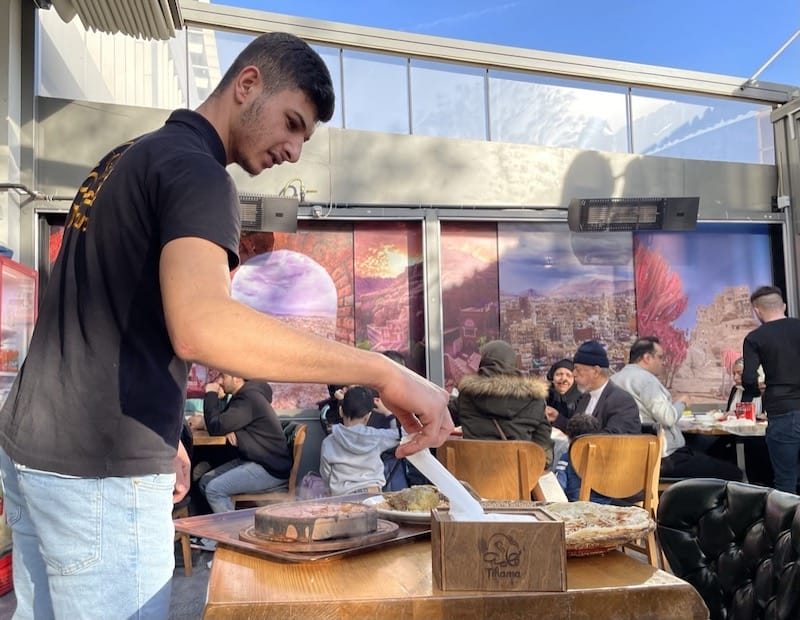
But if you want to try the best of the newcomers, head out west to Tihama in the Istanbul’s suburb of Esenyurt, along the E5 highway that can take you all the way to the Bulgarian border. As cars whizzed by, we sat next to a Yemeni family for a late Saturday lunch on a sunny winter day.
The restaurant’s entrance features Arabesque lights and North African aqua tiles with whole pineapples lining the bar and madhallas, or straw Yemeni hats made of date palm leaves, dangling from above.
“Tihama is a region. It has a mountain range. It includes parts of Saudi Arabia and Yemen. I love this area in general. I have mango farms there,” said Talal Sadik, the manager and head chef, told us in staccato fashion for why he chose the name for the restaurant, which he opened in March of this year. Originally from the province of Ibb, an important gateway to northern Yemen, Talal is trim with greys starting to show in his beard. “Google it. There’s a lot to learn about the area,” he said before he left us to begin eating our maraq, a meat broth soup with pockets of oil, packed with cumin and pepper, in preparation for what was to come.
We ordered the works. Zurbian, fahsah, and the restaurant’s namesake fish, a grouper marinated in a red chili paste, crammed with paprika, and cooked on the bone in the tannour, a technique people in Yemen might have picked up from India, their ancient trading partner across the Arabian Sea. This dish came with khubz rateb, a softer, more supple bread than mulawah, to scoop up the crispy fish, and a version of sahawek mixed with cheese to cool things down when our tongues needed respite.

Talal described how Tihama is in a more remote, residential area than other Yemeni restaurants in Istanbul. “We started where others left off,” he said. He saw a gap in the market and the restaurant has become an instant favorite for Yemeni denizens in the city.
“Look, everyone who comes here are regulars,” Talal said in explaining his need to keep the quality of the restaurant consistently high. “We get the occasional visitor or maybe a brother of someone who comes from abroad for a hair transplant, but still, it is mainly regulars.” Restaurants closer to the city center rely on tourists and may try to cut corners, but Talal has to answer to his customers every week. Fortunately, he doesn’t face the cyclical challenge that other restaurants face in securing a Yemeni chef if someone leaves. “I am the head chef,” he reminded us. “I came up with all the recipes.”
As the meal finished and we turned to rounds of sweet Adeni tea, our focus began to shift from the foreground to the background. We saw family and friends from Yemen, Iraq, Afghanistan and Turkey digging in. It appears many can find something from their own culture in Yemeni cuisine. Yet, even with all these influences, Yemeni food unapologetically stands on its own. This might explain the rise in the number of Yemeni restaurants throughout the city. That, or the fact that it fits in with the local pastime of scooping and dipping, it seems.
Joshua LevkowitzJoshua Levkowitz
Published on January 04, 2023
Related stories
November 20, 2023
IstanbulTucked away on the fourth floor of a nondescript building in the heart of Istanbul's Beyoğlu districts lies a hidden gem that we just discovered, despite the fact that Antakya Mutfağı has been in business for twenty years. Here, the Kar family serves up the cuisine of the southern province of Hatay, which boasts some…
June 23, 2023
IstanbulIn every corner of Istanbul, enticing traces of Turkish cuisine from throughout the country, as well as the cooking of other neighboring regions, can be tucked away in the city's backstreets. These range from a Bulgarian kebab joint in Bağcılar on the western European side to a Bosnian meyhane in Pendik on the eastern stretches…
December 20, 2022
IstanbulDespite 2022 being shaped by Turkey's deep economic crisis, Istanbul's restaurant scene remained resilient amid three-digit inflation and prices that seemed to increase every other day. Nevertheless, many bars, restaurants and tavernas stayed full as people turned to food and drink to help cope. With all Covid-19 restrictions removed, the sector enjoyed its best year…













































